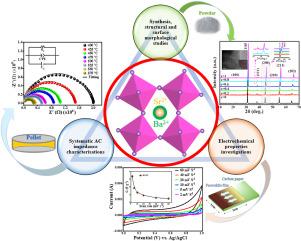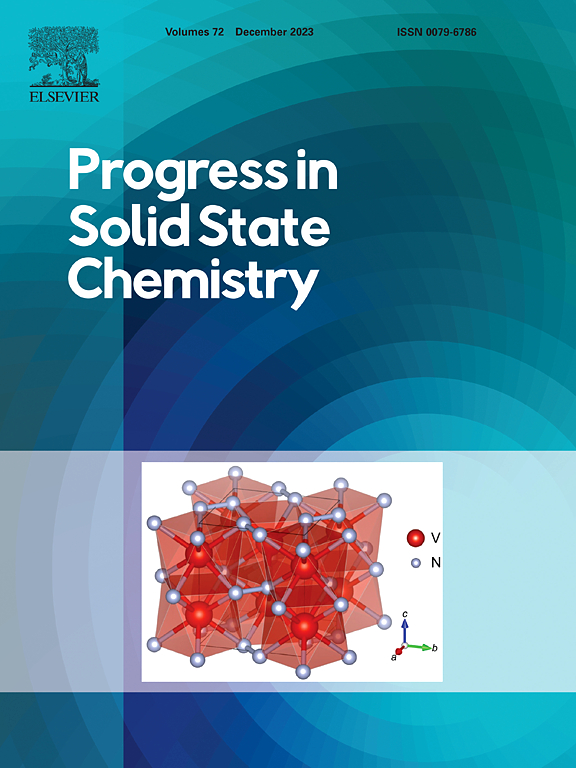Investigation of Sr-substituted Ba1-xSrx(Zn1/3Nb2/3)O3 complex perovskites: Structural, electrical and electrochemical properties
IF 10.5
2区 化学
Q1 CHEMISTRY, INORGANIC & NUCLEAR
引用次数: 0
Abstract
Herein we report the structural, dielectric and electrochemical properties of Ba1-xSrx(Zn1/3Nb2/3)O3 (BSZN, 0 ≤ x ≤ 1) solid solution synthesised by solid-state reaction. A complete substitutional solid solution was obtained, wherein the BSZN cubic perovskites of the space group of Pm m were obtained at x ≤ 0.6 while the pseudo-cubic phases were discernible at x > 0.6. The nano-sized crystallites, as determined by both Scherrer and Williamson-Hall analyses, supported the claim of large polyhedral grains of 0.1–0.3 μm by FE-SEM. Both ε′ and tan δ were found to vary consistently with increasing dopant concentration, except for an anomalous observation for the composition, x = 0.6 with the lowest tan δ of 0.0783 and the highest ε′ of 27.5. Such phenomenon could be attributed to the combined effects of larger grain size, higher relative density and stronger polarisation per molar volume. The impedance analysis revealed that these BSZN perovskites were of the negative temperature coefficient of resistance (NTCR) type. The combined plots of imaginary modulus (M″) and impedance (Z″) against frequency showed the short-range movement of localised charge carriers, suggesting a non-Debye-type relaxation process.

研究锶取代的 Ba1-xSrx(Zn1/3Nb2/3)O3 复合包晶:结构、电学和电化学特性
在此,我们报告了通过固态反应合成的 Ba1-xSrx(Zn1/3Nb2/3)O3(BSZN,0 ≤ x ≤ 1)固溶体的结构、介电和电化学特性。在 x ≤ 0.6 时,获得了空间群为 Pm 3‾m 的 BSZN 立方包晶,而在 x > 0.6 时,则可以看到假立方相。通过舍勒分析和威廉森-霍尔分析确定的纳米级结晶支持了通过 FE-SEM 确定的 0.1-0.3 μm 大多面体晶粒的说法。随着掺杂剂浓度的增加,ε′和tan δ都发生了一致的变化,除了成分 x = 0.6 的异常观察,其最低的 tan δ为 0.0783,最高的ε′为 27.5。这种现象可归因于较大的晶粒尺寸、较高的相对密度和单位摩尔体积较强极化的综合影响。阻抗分析表明,这些 BSZN 包晶属于负温度系数电阻(NTCR)类型。假想模量(M″)和阻抗(Z″)与频率的组合图显示了局部电荷载流子的短程运动,表明这是一种非德拜型弛豫过程。
本文章由计算机程序翻译,如有差异,请以英文原文为准。
求助全文
约1分钟内获得全文
求助全文
来源期刊

Progress in Solid State Chemistry
化学-无机化学与核化学
CiteScore
14.10
自引率
3.30%
发文量
12
期刊介绍:
Progress in Solid State Chemistry offers critical reviews and specialized articles written by leading experts in the field, providing a comprehensive view of solid-state chemistry. It addresses the challenge of dispersed literature by offering up-to-date assessments of research progress and recent developments. Emphasis is placed on the relationship between physical properties and structural chemistry, particularly imperfections like vacancies and dislocations. The reviews published in Progress in Solid State Chemistry emphasize critical evaluation of the field, along with indications of current problems and future directions. Papers are not intended to be bibliographic in nature but rather to inform a broad range of readers in an inherently multidisciplinary field by providing expert treatises oriented both towards specialists in different areas of the solid state and towards nonspecialists. The authorship is international, and the subject matter will be of interest to chemists, materials scientists, physicists, metallurgists, crystallographers, ceramists, and engineers interested in the solid state.
 求助内容:
求助内容: 应助结果提醒方式:
应助结果提醒方式:


